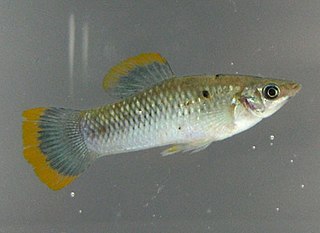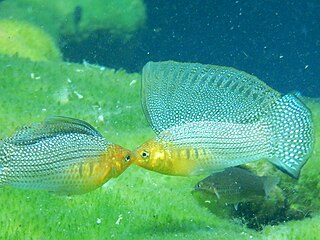
Poecilia is a genus of fishes in the family Poeciliidae of the order Cyprinodontiformes. These livebearers are native to fresh, brackish and salt water in the Americas, and some species in the genus are euryhaline. A few have adapted to living in waters that contain high levels of toxic hydrogen sulfide and a population of P. mexicana lives in caves.

The sailfin molly is a livebearer fish typically found in both freshwater and brackish waterways along the East Coast of the United States, from North Carolina south to Florida, and around the Gulf of Mexico to Texas, and south to the Yucatán Peninsula of Mexico. Given their preference for more brackish water conditions, mollies are often found within just a few yards or miles of the ocean, inhabiting coastal estuaries, lagoons, river deltas and swamps, as well as tidal areas with a regular inflow of oceanic minerals and nutrients mixing with inland freshwater sources.
The widemouth gambusia is a species of fish in the family Poeciliidae of the order Cyprinodontiformes. It is endemic to Mexico, specifically to the Baños del Azufre near Teapa, Tabasco. The Baños del Azufre are sulfidic springs that contain high concentrations of toxic hydrogen sulfide. This prevents most animals from living in them; the only other fish found in the toxic sections of Baños del Azufre is the sulphur molly.

Poecilia sphenops, called the Mexican molly or simply the molly, is a species of poeciliid fish from Central America. It was once understood as a widespread species with numerous local variants ranging from Mexico to Venezuela, but these variants are today considered distinct species belonging to the P. sphenops complex and P. sphenops itself as being native to Mexico, Guatemala, and Honduras. Due in part to its popularity as an aquarium fish, the species has been introduced outside of its native range, but many records may in fact refer to P. mexicana or other species from the complex. P. sphenops has been crossbred with other mollies, notably P. latipinna and P. velifera, to produce fancy mollies for the ornamental fish trade.

The Ash Meadows killifish is a species of killifish from the subfamily Empetrichthyinae, part of the family Goodeidae, which was first documented by C. H. Gilbert in 1893 and historically occupied numerous springs near Ash Meadows, Nye County, Nevada, United States. This species was last seen in 1948 and is believed to have gone extinct in the early 1950s, likely as a result of habitat alteration and competition with and predation by introduced crayfish Procambarus clarkii, mosquitofish, black mollies, and bullfrogs.

The Amazon molly is a freshwater fish native to the warm waters of northeastern Mexico and the southern parts of the U.S. state of Texas. It reproduces through gynogenesis, and essentially all individuals are females. The common name of "Amazon molly," acknowledges this trait as a reference to the Amazon warriors, a female-run society in Greek mythology. The Amazon molly is a hybrid species, and its parent species are the sailfin molly and the Atlantic molly. In 1932, this species was the first vertebrate confirmed to be capable of asexual reproduction.

Poecilia wingei, known to aquarists as Endlers or Endler's livebearer, in the genus Poecilia, is a small fish native to the Paria Peninsula in Venezuela. They are prolific breeders and often hybridize with guppies. These very colorful hybrids are the easiest to find being offered in pet-shops, typically under the name Endler's guppy.

Limia is a genus of livebearing fishes belonging to the Cyprinodontiform family Poeciliidae. It comprises 22 described species found in fresh, brackish, saltwater, and hypersaline habitats of the Greater Antilles islands in the Caribbean Sea. A vast majority are endemic to Hispaniola. There has been a long-running debate on whether Limia should be considered a subgenus of Poecilia rather than a full genus. Most Limia species are detrivores and herbivores. Due to their small size and coloring, they are sometimes kept in home aquaria.

Poecilia velifera, known as the Yucatan molly and also as the giant sailfin molly amongst aquarists, is a large livebearer that lives in coastal waters of the Yucatan Peninsula. These live-bearer (Poeciliidae) fish are particularly well known for both the extreme size variation among males, and the sexual dimorphism between males and females in both body shape and behavior.

The bonytail chub or bonytail is a cyprinid freshwater fish native to the Colorado River basin of Arizona, California, Colorado, Nevada, New Mexico, Utah and Wyoming in the southwestern United States; it has been extirpated from the part of the basin in Mexico. It was once abundant and widespread in the basin, its numbers and range have declined to the point where it has been listed as endangered since 1980 (ESA) and 1986 (IUCN), a fate shared by the other large Colorado basin endemic fish species like the Colorado pikeminnow, humpback chub, and razorback sucker. It is now the rarest of the endemic big-river fishes of the Colorado River. There are 20 species in the genus Gila, seven of which are found in Arizona.
Haplochromis elegans is a species of cichlid endemic to Uganda where it occurs in Lake George, Lake Edward and the Kazinga Channel. This species can reach a length of 7.3 centimetres (2.9 in) SL.
The broadspotted molly, locally known as molly del Tamesi, is a critically endangered species of fish in the family Poeciliidae, endemic to a small part of the Tamesí River system in Mexico.

The sulphur molly, locally known as molly del Teapa, is an endangered species of fish in the family Poeciliidae. It is endemic to Mexico, specifically to the Baños del Azufre near Teapa, Tabasco. The Baños del Azufre are sulfidic springs that contain high concentrations of toxic hydrogen sulfide. Poecilia sulphuraria has apparently evolved the ability to tolerate the toxic conditions. A few other Poecilia species are known from similar habitats in Mexico.

The guppy, also known as millionfish or the rainbow fish, is one of the world's most widely distributed tropical fish and one of the most popular freshwater aquarium fish species. It is a member of the family Poeciliidae and, like almost all American members of the family, is live-bearing. Guppies originate from northeast South America, but have been introduced to many environments and are now found all over the world. They are highly adaptable and thrive in many different environmental and ecological conditions. Male guppies, which are smaller than females, have ornamental caudal and dorsal fins. Wild guppies generally feed on a variety of food sources, including benthic algae and aquatic insect larvae. Guppies are used as a model organism in the fields of ecology, evolution, and behavioural studies.

Omobranchus elegans is a species of combtooth blenny found in the Northwest Pacific ocean. This species can reach a length of 6.0 centimetres (2.4 in) TL.

Poecilia mexicana, commonly known as the shortfin molly or Atlantic molly, is a species of poeciliid fish native to fresh and brackish water in Mexico and Guatemala. One population is found in caves and known as the cave molly.
Poecilia petenensis, the Petén molly, is a poeciliid fish species endemic to Guatemala.

Poecilia gillii, Gill's molly, is a herbivorous livebearer fish distributed throughout Central America. It is found in both moving and still water as well as in both freshwater and brackish habitats. Populations of this species differ in color, size, and morphology.

Poecilia chica, the dwarf molly, is a livebearer fish from the Mexican state of Jalisco. The fish are small and exceptionally colorful. The dominant male may become completely black, which is a unique ability in the Mollienesia subgenus.














